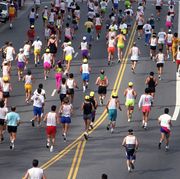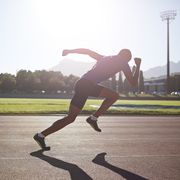Craig asks: My question is about nutrition on longer runs as I train for my first marathon. I’ve read that I’m burning about 100 calories per mile, so am I supposed to be taking in that much nutrition during these runs to counter that loss? What else do I need to know when it comes to staying properly fueled as my runs increase in length?
While it’s true that you may be burning approximately 100 calories per mile on your runs—give or take depending upon pace and your body mass—the purpose of taking in midrun nutrition is more related to keeping up blood sugar and glycogen levels rather than replacing lost calories. It would be difficult to take in 100 calories for each mile while running given that your GI system is not operating at full capacity during exercise. (Not to mention, eating 2,000 calories per run on top of refueling afterward and normal eating may lead to some weight gain.)
Thankfully, our bodies are designed with energy pathways that help carry us for many miles.
Our bodies burn a blend of fuel for energy needs: stored carbohydrate (referred to as glycogen) and stored fat. A pound of body fat contains 3,500 calories, more than enough to run a marathon, so we have plenty of energy on board. The problem often becomes accessing and using it for fuel.
How much glycogen we store is more limited: about 2,000 calories. So if you burn about 100 calories per mile, by 20 miles, your stores can be depleted. And that’s when you might hit “the wall”.
Hitting the wall is akin to your car running out of gas. It means you have used all of your stored glycogen, and accessing fat as fuel becomes crucial. The beauty is we do not burn just one or the other, but rather we burn a blend of both fat and glycogen all the time. The ratio of the two varies based upon the intensity and duration of the run. The lower the intensity and the longer the run, the higher the percentage of fat is used for fuel, and the lower the percentage of glycogen. The higher the intensity and the shorter the run (like a track workout or other interval training), the higher the percentage of glycogen is used for fuel.
RELATED: High Carb Meals to Fuel Your Long Run
With endurance training, runners can increase the rate at which fat can be used as fuel, which allows them to run longer and conserve glycogen. This is one of the primary purposes of your long run days and why it is important to do these runs at a slower pace to encourage fat metabolism.
While your muscles use a combination of fat and glycogen, your brain can only glucose for fuel. That's why swishing sports drink and spitting can be an effective way to add a little extra kick to your run—your brain is perked up by the carbs in your mouth.
How much nutrition you will need while on the go varies from runner to runner. Training is the time to experiment so that by race day you will know how much fuel you will need and what types work for you. (And if you are looking for great meals to make at home that keep you fueled up, check out Meals on the Run.)
RELATED: How to Fuel Your First Marathon
While you want to avoid low blood sugar and running out of glycogen, consuming too much nutrition midrun can cause GI issues. During training, take a minimal approach and increase supplementation gradually to find the right balance for you. For runs 60 minutes or longer, consume 30 to 60 grams of carbohydrate—an energy gel, a handful of chews, a small pack of raisins—every 30 to 45 minutes.
Have a few sips of water every time you eat—washing your fuel down with sports drink can overwhelm the GI system thanks to the sugar content. Can’t eat that much while moving? Alternate between food and sports drink. For example, switch off fueling with sports drink and food.
Related: Be sure to try some of these great meals for summer.
Susan Paul has coached more than 2,000 runners and is an exercise physiologist and program director for the Orlando Track Shack Foundation. For more information, visit www.trackshack.com.













